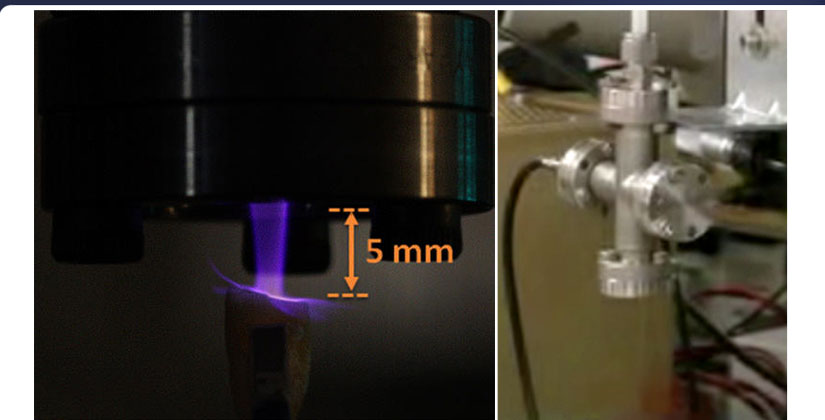




Biocompatible Helium/Oxygen Plasma Torch
Cool Plasma Blowtorch Kills Plaque, Cleans Teeth... [Photos and Video]
by Stuart Fox for Popular Science
June 11, 2009
Cool Plasma Pack Heat Against Biofilms
by Beth Dunham for University of Southern California News
June 5, 2009
Though it looks like a tiny purple blowtorch, a pencil-sized plume of plasma on the tip of a small probe remains at room temperature as it swiftly dismantles tough bacterial colonies deep inside a human tooth.
It's not another futuristic product of George Lucas' imagination - it's the exciting work of USC School of Dentistry and USC Viterbi School of Engineering researchers looking for new ways to safely fight tenacious biofilm infections in patients.
Two of the study's authors are Chunqi Jiang, a research assistant professor in the Ming Hsieh Department of Electrical Engineering-Electrophysics, and Parish Sedghizadeh, assistant professor of clinical dentistry and director of the USC Center for Biofilms. "Nanosecond Pulsed Plasma Dental Probe" appears in the June issue of Plasma Processes and Polymers.
Sedghizadeh explained that biofilms are complex colonies of bacteria suspended in a slimy matrix that grants them added protection from conventional antibiotics. Biofilms are responsible for many hard-to-fight infections in the mouth and elsewhere. But in the study, biofilms cultivated in the root canal of extracted human teeth were easily destroyed with the plasma dental probe, as evidenced by scanning electron microscope images of near-pristine tooth surfaces after plasma treatment.
Plasma, the fourth state of matter, consists of electrons, ions and neutral species and is the most common form found in space, stars and lightning, Jiang said. But while many natural plasmas are hot, or thermal, the probe developed for the study is a non-thermal, room-temperature plasma that's safe to touch. The researchers placed temperature sensors on the extracted teeth before treatment and found that the temperature of the tooth increased just five degrees after 10 minutes of exposure to the plasma, Jiang said.
The cooler nature of the experimental plasma comes from its pulsed power supply. Instead of employing a steady stream of energy to the probe, the pulsed power supply sends 100-nanosecond pulses of several kilovolts to the probe once every millisecond, with an average power less than two watts, Jiang said.
"Atomic oxygen [a single atom of oxygen, instead of the more common O2 molecule] appears to be the antibacterial agent," according to plasma emission spectroscopy obtained during the experiments, she said.
Sedghizadeh said the oxygen-free radicals might be disrupting the cellular membranes of the biofilms in order to cause their demise and that the plasma plume's adjustable, fluid reach allowed the disinfection to occur even in the hardest-to-reach areas of the root canal. Given that preliminary research indicates that non-thermal plasma is safe for surrounding tissues, Sedghizadeh said he was optimistic about its future dental and medical uses.
"Plasma is the future," Sedghizadeh said. "It's been used before for other sterilization purposes but not for clinical medical applications, and we hope to be the first to apply it in a clinical setting."
"We believe we're the first team to apply plasma for biofilm disinfection in root canals," Jiang added. "This collaboration is unique. We're attacking frontier problems, and we're happy to be broadening our fields."
Analysis
This breakthrough dental technology will no doubt find significant applications in the therapeutic bioelectrification of the human body. Further advancements in the field of biocompatible plasmas will replicate the HHO plasma chambers of the Great Pyramid of Giza, Egypt, where human beings experienced enhanced consciousness through the use of colloidal gold and silver waters for the illumination of DNA.
An interesting example of this process of cleansing the body by use of vacuum chambers flooded with biocompatible HHO plasma was given in the 1960s by Dr. Raymond Bernard, in his account of interactions with an advanced subterranean civilization near the Brazilian city of Joinville.